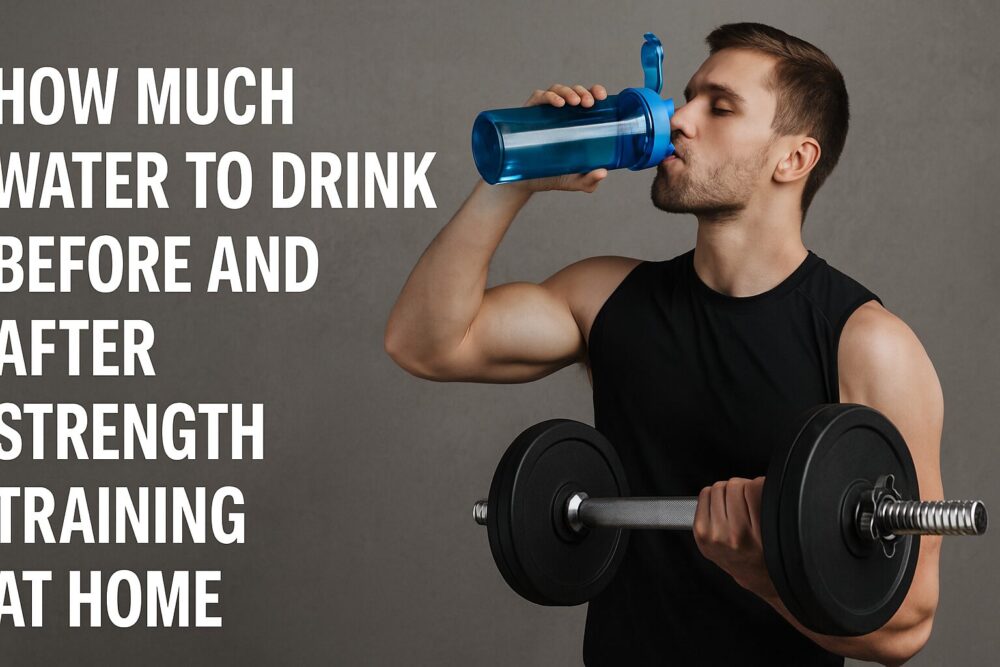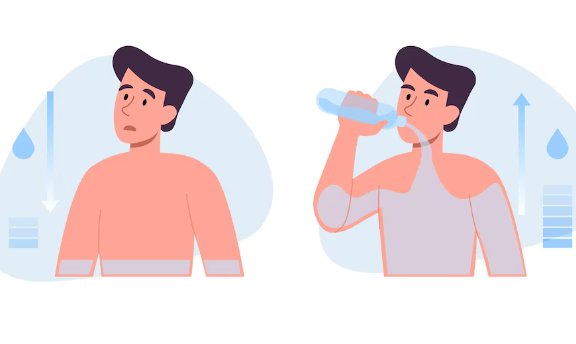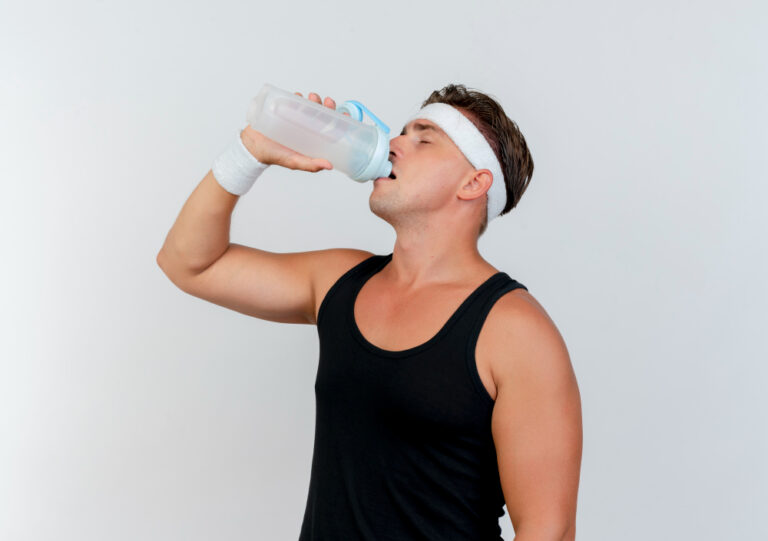Ever started a strength training session at home feeling like a champion… only to end up feeling like a wilted houseplant halfway through? Yeah, me too. That’s the power of poor hydration, it can turn your deadlifts into “dead-feels” and your push-ups into “push-uh-ohs.”
The good news? Knowing how much water to drink before and after strength training at home can be the difference between a PR (personal record) and a DNS (did not survive).
Let’s break it down, science-style, but without the boring lab coat.
Why Hydration Is Your Secret Training Partner
Hydration isn’t just about avoiding thirst, it’s about fueling your muscles, lubricating your joints, and keeping your blood flowing like the freeway on a Sunday morning (not Monday rush hour). When you’re lifting at home, you don’t have gym air-conditioning or a water fountain ten feet away, so pre-workout and post-workout hydration become even more crucial.
Studies have shown that even 1–2% dehydration can impair performance, reduce strength output, and slow recovery (NIH). In other words, lifting dehydrated is like trying to stream Netflix with one bar of Wi-Fi.
Pre-Workout Hydration Guidelines
The goal before you train is to start hydrated, not to chug a gallon of water minutes before your workout and then regret it during squats.
2–3 Hours Before Training
- Drink 17–20 oz (about 500–600 ml) of water.
This allows your body to absorb and distribute fluids without leaving you bloated.
20–30 Minutes Before Training
- Top up with 8–16 oz (250–500 ml).
Think of it as your “final fuel stop” before hitting the iron.
💡 Pro Tip: If you train first thing in the morning, you’re already mildly dehydrated from sleep. Start with a full glass of water as soon as you wake up.
If you’re training during an intermittent fasting window, check out the best foods for intermittent fasting and hydration, because fasting and hydration are a delicate duo.
Hydration During Strength Training
While strength training isn’t as sweat-draining as a HIIT sprint session, dehydration can still creep up, especially in warm rooms or intense circuits.
General Rule: Sip 7–10 oz every 10–20 minutes.
You’re not trying to replace all fluid loss mid-workout, just keep the tank from hitting “empty.”
If your strength session turns into a hybrid HIIT workout, you’ll want to adjust your strategy. Here’s a detailed breakdown of hydration needs for HIIT workouts at home that’s worth bookmarking.
Post-Workout Rehydration: Your Recovery Accelerator
This is where most home lifters drop the ball. They smash their last rep, hit the shower, and forget to replenish fluids, then wonder why they feel sore and sluggish the next day.
The Science-Backed Formula:
- Drink 16–24 oz of water for every pound lost during your workout (National Institutes of Health).
- If you don’t weigh yourself, a safe bet is 20–24 oz over the next hour after training.
Why It Matters: Post-workout hydration supports:
- Muscle protein synthesis (repair & growth).
- Joint recovery (less soreness, better mobility).
- Glycogen replenishment (restores your strength for tomorrow).
Electrolytes: When to Bring in the Reinforcements
If you train in a hot room, sweat heavily, or your session lasts over an hour, water alone might not cut it. Sodium, potassium, and magnesium help your body retain and use that water effectively.
You can get electrolytes from:
- Sports drinks (low sugar options).
- Coconut water.
- DIY mix: pinch of salt + squeeze of lemon + water.
Avoiding Over-hydration (Yes, It’s a Thing)
When people talk about hydration, the advice often sounds like: “Drink more water!” But here’s the plot twist, you can drink too much, and the consequences aren’t pretty. This is called over-hydration or water intoxication, and while it’s far less common than dehydration, it can be just as dangerous.
What Happens When You Overdo It?
Over-hydration dilutes the sodium in your bloodstream, leading to a condition called hyponatremia. Sodium is an electrolyte that helps regulate muscle contractions, nerve signals, and fluid balance. When your sodium levels drop too low, your body’s cells begin to swell — including brain cells.
Symptoms range from mild to scary:
- Headaches and nausea
- Muscle cramps or twitching
- Confusion or disorientation
- In severe cases, seizures or coma
According to the Mayo Clinic, most healthy adults won’t get hyponatremia just from sipping water during normal workouts, but it can happen if you drink excessive amounts (think more than 48 oz / 1.4 liters per hour) without replacing electrolytes.
Smart Hydration Tips for At-Home Strength Training
- Keep a Measured Bottle Nearby: Know exactly how much you’re drinking.
- Adjust for Room Temp: Hotter rooms = higher sweat loss = more fluids needed.
- Use Urine Color as a Gauge: Pale yellow = good, dark yellow = drink more.
- Pair Water with Recovery Foods: If you train fasted, choose hydrating snacks post-workout.
- Log It: Use a hydration app or your phone notes to stay consistent.
Personalized Hydration: One Size Doesn’t Fit All
All these numbers are great, but your hydration needs to depend on:
1. Body Size
Bigger bodies = bigger water needs.
Water volume is directly related to lean body mass because muscle tissue is about 75% water ). A 90 kg lifter has more muscle tissue to hydrate than someone weighing 60 kg, so they’ll naturally need more fluid to maintain performance. Think of it as filling a bigger water tank, it just takes more to get it full.
2. Workout Duration & Intensity
The longer and harder you train, the more you sweat, and the more water you lose. High-volume strength training (e.g., 90 minutes of supersets and heavy lifts) will tax your system more than a quick 30-minute bodyweight session.
Intense sessions also increase core temperature, which drives your body to sweat more to cool down. Even if you’re training at home, those long grinding sets of deadlifts or high-rep squats can put your hydration to the test.
3. Sweat Rate
Some people are “light sweaters,” others sweat like they’re in a sauna after two push-ups. Sweat rate is influenced by genetics, fitness level, and even diet (high sodium intake can increase sweating). The key problem here isn’t just fluid loss, it’s electrolyte loss along with that fluid.
If you’re drenched halfway through your workout, you’re losing water and sodium faster, which means rehydration needs to be more aggressive post-workout. This is where electrolytes become especially important for strength training recovery.
4. Climate
Training in a cool, air-conditioned space is completely different from cranking out sets in a warm garage gym in summer. Hotter environments speed up sweat evaporation, meaning you lose more water even if you don’t notice it dripping.
Humidity makes it even trickier, sweat can’t evaporate as easily, so your body works harder to regulate temperature, which can lead to faster dehydration.
That’s why I recommend using our Free Water Intake Calculator, it factors in your weight, workout type, and environment to give you your exact number. You can try it right here for free.
Hydration Mistakes to Avoid
- Only drinking when thirsty: Thirst lags behind your body’s actual needs.
- Slamming water right before lifting: Hello, stomach cramps.
- Ignoring electrolytes during long/hot sessions: You’ll feel the crash later.
- Forgetting post-workout fluids: Recovery starts here, not in the protein shake.
Conclusion
If you want peak strength, faster recovery, and fewer “I can’t move” moments the next day, hydration is non-negotiable. The simple framework is:
- Before: 17–20 oz (2–3 hrs prior), + 8–16 oz (20–30 min prior)
- During: Sip 7–10 oz every 10–20 min
- After: 16–24 oz per pound lost
Want to go deeper into hydration science? Don’t miss the ultimate guide to hydration, it’s the big brother to this article.
FAQ
Should I drink water right before strength training at home?
Yes, but in moderation. About 8–16 oz (250–500 ml) 20–30 minutes before training is ideal. Chugging a large amount immediately before lifting can cause stomach discomfort and bloating, which may affect performance.
How much water should I drink after strength training?
A good rule is 16–24 oz for every pound lost during your workout. If you don’t weigh yourself, aim for 20–24 oz in the first hour post-workout to support muscle recovery and replenish fluids.
Can I drink too much water after a workout?
Yes. Overhydration can cause hyponatremia, a dangerous drop in blood sodium levels. Avoid drinking more than 48 oz (1.4 liters) in an hour and balance your intake with electrolytes if you’ve sweated heavily.
Does hydration really affect strength performance?
Absolutely. Even 1–2% dehydration can impair muscle strength, reduce endurance, and slow recovery. Staying hydrated helps maintain energy levels, joint health, and focus during your workout.







